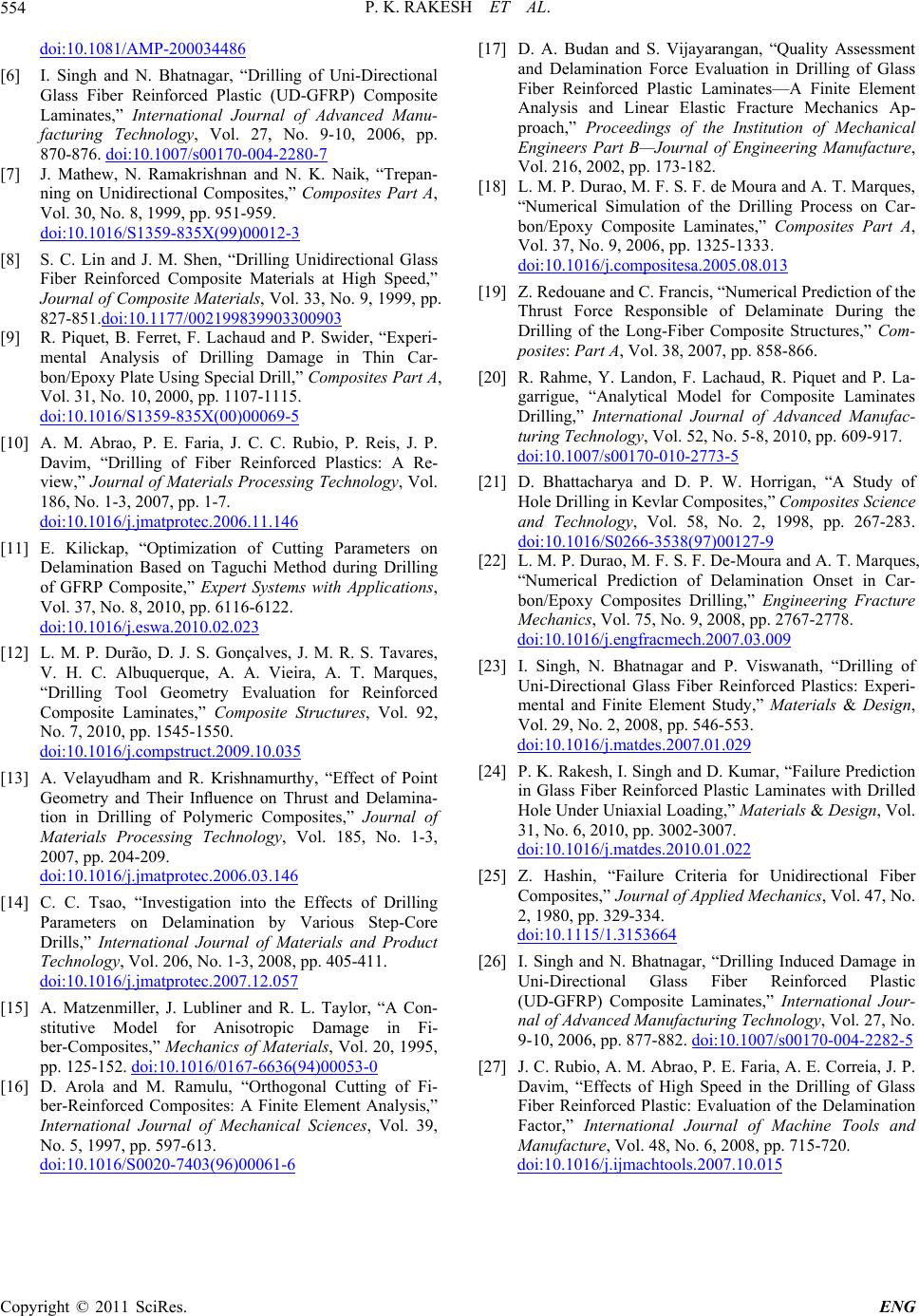
P. K. RAKESH ET AL.
Copyright © 2011 SciRes. ENG
554
doi:10.1081/AMP-200034486
[6] I. Singh and N. Bhatnagar, “Drilling of Uni-Directional
Glass Fiber Reinforced Plastic (UD-GFRP) Composite
Laminates,” International Journal of Advanced Manu-
facturing Technology, Vol. 27, No. 9-10, 2006, pp.
870-876. doi:10.1007/s00170-004-2280-7
[7] J. Mathew, N. Ramakrishnan and N. K. Naik, “Trepan-
ning on Unidirectional Composites,” Composites Part A,
Vol. 30, No. 8, 1999, pp. 951-959.
doi:10.1016/S1359-835X(99)00012-3
[8] S. C. Lin and J. M. Shen, “Drilling Unidirectional Glass
Fiber Reinforced Composite Materials at High Speed,”
Journal of Composite Materials, Vol. 33, No. 9, 1999, pp.
827-851.doi:10.1177/002199839903300903
[9] R. Piquet, B. Ferret, F. Lachaud and P. Swider, “Experi-
mental Analysis of Drilling Damage in Thin Car-
bon/Epoxy Plate Using Special Drill,” Composites Part A,
Vol. 31, No. 10, 2000, pp. 1107-1115.
doi:10.1016/S1359-835X(00)00069-5
[10] A. M. Abrao, P. E. Faria, J. C. C. Rubio, P. Reis, J. P.
Davim, “Drilling of Fiber Reinforced Plastics: A Re-
view,” Journal of Materials Processing Technology, Vol.
186, No. 1-3, 2007, pp. 1-7.
doi:10.1016/j.jmatprotec.2006.11.146
[11] E. Kilickap, “Optimization of Cutting Parameters on
Delamination Based on Taguchi Method during Drilling
of GFRP Composite,” Expert Systems with Applications,
Vol. 37, No. 8, 2010, pp. 6116-6122.
doi:10.1016/j.eswa.2010.02.023
[12] L. M. P. Durão, D. J. S. Gonçalves, J. M. R. S. Tavares,
V. H. C. Albuquerque, A. A. Vieira, A. T. Marques,
“Drilling Tool Geometry Evaluation for Reinforced
Composite Laminates,” Composite Structures, Vol. 92,
No. 7, 2010, pp. 1545-1550.
doi:10.1016/j.compstruct.2009.10.035
[13] A. Velayudham and R. Krishnamurthy, “Effect of Point
Geometry and Their Influence on Thrust and Delamina-
tion in Drilling of Polymeric Composites,” Journal of
Materials Processing Technology, Vol. 185, No. 1-3,
2007, pp. 204-209.
doi:10.1016/j.jmatprotec.2006.03.146
[14] C. C. Tsao, “Investigation into the Effects of Drilling
Parameters on Delamination by Various Step-Core
Drills,” International Journal of Materials and Product
Technology, Vol. 206, No. 1-3, 2008, pp. 405-411.
doi:10.1016/j.jmatprotec.2007.12.057
[15] A. Matzenmiller, J. Lubliner and R. L. Taylor, “A Con-
stitutive Model for Anisotropic Damage in Fi-
ber-Composites,” Mechanics of Materials, Vol. 20, 1995,
pp. 125-152. doi:10.1016/0167-6636(94)00053-0
[16] D. Arola and M. Ramulu, “Orthogonal Cutting of Fi-
ber-Reinforced Composites: A Finite Element Analysis,”
International Journal of Mechanical Sciences, Vol. 39,
No. 5, 1997, pp. 597-613.
doi:10.1016/S0020-7403(96)00061-6
[17] D. A. Budan and S. Vijayarangan, “Quality Assessment
and Delamination Force Evaluation in Drilling of Glass
Fiber Reinforced Plastic Laminates—A Finite Element
Analysis and Linear Elastic Fracture Mechanics Ap-
proach,” Proceedings of the Institution of Mechanical
Engineers Part B—Journal of Engineering Manufacture,
Vol. 216, 2002, pp. 173-182.
[18] L. M. P. Durao, M. F. S. F. de Moura and A. T. Marques,
“Numerical Simulation of the Drilling Process on Car-
bon/Epoxy Composite Laminates,” Composites Part A,
Vol. 37, No. 9, 2006, pp. 1325-1333.
doi:10.1016/j.compositesa.2005.08.013
[19] Z. Redouane and C. Francis, “Numerical Prediction of the
Thrust Force Responsible of Delaminate During the
Drilling of the Long-Fiber Composite Structures,” Com-
posites: Part A, Vol. 38, 2007, pp. 858-866.
[20] R. Rahme, Y. Landon, F. Lachaud, R. Piquet and P. La-
garrigue, “Analytical Model for Composite Laminates
Drilling,” International Journal of Advanced Manufac-
turing Technology, Vol. 52, No. 5-8, 2010, pp. 609-917.
doi:10.1007/s00170-010-2773-5
[21] D. Bhattacharya and D. P. W. Horrigan, “A Study of
Hole Drilling in Kevlar Composites,” Composites Science
and Technology, Vol. 58, No. 2, 1998, pp. 267-283.
doi:10.1016/S0266-3538(97)00127-9
[22] L. M. P. Durao, M. F. S. F. De-Moura and A. T. Marques,
“Numerical Prediction of Delamination Onset in Car-
bon/Epoxy Composites Drilling,” Engineering Fracture
Mechanics, Vol. 75, No. 9, 2008, pp. 2767-2778.
doi:10.1016/j.engfracmech.2007.03.009
[23] I. Singh, N. Bhatnagar and P. Viswanath, “Drilling of
Uni-Directional Glass Fiber Reinforced Plastics: Experi-
mental and Finite Element Study,” Materials & Design,
Vol. 29, No. 2, 2008, pp. 546-553.
doi:10.1016/j.matdes.2007.01.029
[24] P. K. Rakesh, I. Singh and D. Kumar, “Failure Prediction
in Glass Fiber Reinforced Plastic Laminates with Drilled
Hole Under Uniaxial Loading,” Materials & Design, Vol.
31, No. 6, 2010, pp. 3002-3007.
doi:10.1016/j.matdes.2010.01.022
[25] Z. Hashin, “Failure Criteria for Unidirectional Fiber
Composites,” Journal of Applied Mechanics, Vol. 47, No.
2, 1980, pp. 329-334.
doi:10.1115/1.3153664
[26] I. Singh and N. Bhatnagar, “Drilling Induced Damage in
Uni-Directional Glass Fiber Reinforced Plastic
(UD-GFRP) Composite Laminates,” International Jour-
nal of Advanced Manufacturing Technology, Vol. 27, No.
9-10, 2006, pp. 877-882. doi:10.1007/s00170-004-2282-5
[27] J. C. Rubio, A. M. Abrao, P. E. Faria, A. E. Correia, J. P.
Davim, “Effects of High Speed in the Drilling of Glass
Fiber Reinforced Plastic: Evaluation of the Delamination
Factor,” International Journal of Machine Tools and
Manufacture, Vol. 48, No. 6, 2008, pp. 715-720.
doi:10.1016/j.ijmachtools.2007.10.015